
Dessert is a course that concludes a meal. The course consists of sweet foods, such as cake, biscuit, ice cream and possibly a beverage such as dessert wine and liqueur. Some cultures sweeten foods that are more commonly savory to create desserts. In some parts of the world there is no tradition of a dessert course to conclude a meal.
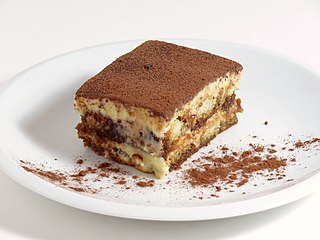
Tiramisu is an Italian dessert made of ladyfinger pastries (savoiardi) dipped in coffee, layered with a whipped mixture of eggs, sugar and mascarpone and flavoured with cocoa. The recipe has been adapted into many varieties of cakes and other desserts. Its origin is disputed between the Italian regions of Veneto and Friuli-Venezia Giulia. The name comes from the Italian tirami su.

Hungarian or Magyar cuisine is the cuisine characteristic of the nation of Hungary, and its primary ethnic group, the Magyars. Hungarian cuisine has been described as being the spiciest cuisine in Europe This can largely be attributed to the use of their piquant native spice, Hungarian paprika, in many of their dishes. A mild version of the spice, Hungarian sweet paprika, is commonly used as an alternative. Traditional Hungarian dishes are primarily based on meats, seasonal vegetables, fruits, bread, and dairy products.

Advocaat or advocatenborrel is a traditional Dutch alcoholic beverage made from eggs, sugar, and brandy. The rich and creamy drink has a smooth, custard-like consistency. The typical alcohol content is generally between 14% and 20% ABV. Its contents may be a blend of egg yolks, aromatic spirits, sugar or honey, brandy, vanilla, and sometimes cream. Notable makers of advocaat include Warninks, Bols, Darna Ovo Liker, DeKuyper, and Verpoorten.

Biscotti or cantucci are Italian almond biscuits that originated in the Tuscan city of Prato. They are twice-baked, oblong-shaped, dry, crunchy, and may be dipped in a drink, traditionally Vin Santo. Smaller biscotti may be aknown as known as biscottini or cantuccini.

A macaron or French macaroon is a sweet meringue-based confection made with egg white, icing sugar, granulated sugar, almond meal, and often food colouring.

Central Italy is one of the five official statistical regions of Italy used by the National Institute of Statistics (ISTAT), a first-level NUTS region, and a European Parliament constituency.

Almond paste is made from ground almonds or almond meal and sugar in equal quantities, with small amounts of cooking oil, beaten eggs, heavy cream or corn syrup added as a binder. It is similar to marzipan, but has a coarser texture. Almond paste is used as a filling in pastries, but it can also be found in chocolates. In commercially manufactured almond paste, ground apricot or peach kernels are sometimes added to keep the cost down.
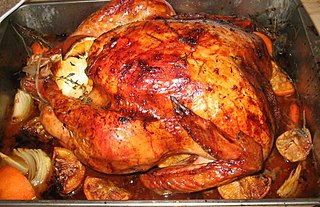
Christmas dinner is a meal traditionally eaten at Christmas. This meal can take place any time from the evening of Christmas Eve to the evening of Christmas Day itself. The meals are often particularly rich and substantial, in the tradition of the Christian feast day celebration, and form a significant part of gatherings held to celebrate the arrival of Christmastide. In many cases, there is a ritual element to the meal related to the religious celebration, such as the saying of grace.
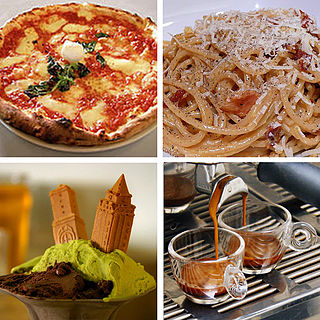
Italian cuisine is a Mediterranean cuisine consisting of the ingredients, recipes and cooking techniques developed in Italy since Roman times and later spread around the world together with waves of Italian diaspora. Some of these foods were imported from other cultures. Significant changes occurred with the colonization of the Americas and the introduction of potatoes, tomatoes, capsicums, maize and sugar beet—the latter introduced in quantity in the 18th century. It is one of the best-known and most appreciated gastronomies worldwide.
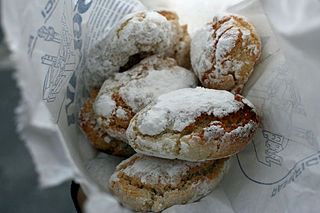
Ricciarelli are traditional Italian biscuits – specifically, a type of macaroon – originating in 14th century Siena. It is considered one of the signature sweets of Siena, in addition to panforte, cenci, and cavallucci.

Tuscan wine is Italian wine from the Tuscany region. Located in central Italy along the Tyrrhenian coast, Tuscany is home to some of the world's most notable wine regions. Chianti, Brunello di Montalcino and Vino Nobile di Montepulciano are primarily made with Sangiovese grape whereas the Vernaccia grape is the basis of the white Vernaccia di San Gimignano. Tuscany is also known for the dessert wine Vin Santo, made from a variety of the region's grapes. Tuscany has forty-one Denominazioni di origine controllata (DOC) and eleven Denominazioni di Origine Controllata e Garantita (DOCG). In the 1970s a new class of wines known in the trade as "Super Tuscans" emerged. These wines were made outside DOC/DOCG regulations but were considered of high quality and commanded high prices. Many of these wines became cult wines. In the reformation of the Italian classification system many of the original Super Tuscans now qualify as DOC or DOCG wines but some producers still prefer the declassified rankings or to use the Indicazione Geografica Tipica (IGT) classification of Toscana. Tuscany has six sub-categories of IGT wines today.

Siena is a city in Tuscany, Italy. It is the capital of the province of Siena. Siena is the 12th largest city in the region by number of inhabitants, with a population of 53,062 as of 2022.
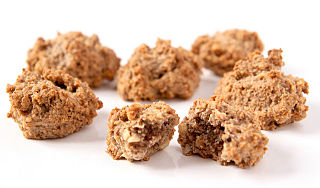
Bruttiboni, also known as mandorlati di San Clemente and brutti ma buoni, is a type of hazelnut or almond-flavoured biscuit made in Prato, Tuscany and many other cities. These cookies are made by incorporating meringue; an egg white and sugar mixture; with roasted chopped nuts. The cookies are crunchy on the outside with a soft texture in the middle. As with many other Italian cookies, their origin is disputed but they have been made since at least the mid-1800s.

Qurabiya also ghraybe, ghorayeba, ghoriba, ghribia, ghraïba, gurabija, ghriyyaba, or kourabiedes and numerous other spellings and pronunciations, is a shortbread-type biscuit, usually made with ground almonds. Versions are found in most Arab and Ottoman cuisines, with various different forms and recipes. They are similar to polvorones from Andalusia.

The flag of Tuscany is the official flag of the region of Tuscany, Italy. The flag depicts a silver Pegasus rampant on a white field between two horizontal red bands. The flag first appeared as a gonfalon on 20 May 1975 along with accompanying text Regione Toscana above the Pegasus. It was officially adopted as the flag of Tuscany on 3 February 1995.

Christmas in Italy begins on 8 December, with the Feast of the Immaculate Conception, the day on which traditionally the Christmas tree is mounted and ends on 6 January, of the following year with the Epiphany, and in some areas female puppets are burned on a pyre, to symbolize, along with the end of the Christmas period, the death of the old year and the beginning of a new one. 26 December, is also a public holiday in Italy. The Italian term Natale derives from the Latin natalis, which literally means 'birth', and the greetings in Italian are buon Natale and felice Natale.

Easter in Italy is one of the country's major holidays. Easter in Italy enters Holy Week with Palm Sunday, Maundy Thursday, Good Friday and Holy Saturday, concluding with Easter Day and Easter Monday. Each day has a special significance. The Holy Weeks worthy of note in Italy are the Holy Week in Barcellona Pozzo di Gotto and the Holy Week in Ruvo di Puglia.


















